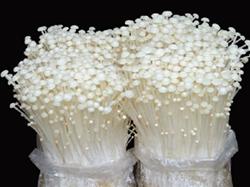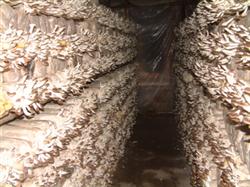Cultivation techniques of Flammulina velutipes: what is Flammulina velutipes witches' branch disease?

What is Flammulina velutipes witches' branch disease? Please introduce and control Flammulina velutipes with long stalk but not cap, commonly known as Flammulina velutipes witches' broom disease, or Flammulina velutipes, which is a non-infectious physiological disease. When the cultivation bag or bottle changes from the mycelium growth to the fruiting body formation stage, the mushroom buds are clustered, only the long stalk does not form a cap, and when the stalk extends to a certain length, the tip produces branches, and the small branches grow again after a certain period of time. The longer the branchlets grow, the weaker and drooping, forming a clump of hair-like hyphae, which is completely different from the normal growth of fruiting body stalks growing upward, and the tip expands to form a cap. The cap is stagnant in the young shape when the primordium develops, and its diameter is about 1-2 mm. The whole mushroom body is beard-shaped, a single mushroom body is short and thin, aseptic cover, the middle and lower part is slightly thicker, shaped like a needle. The growth of fruiting body was seriously inhibited and there was almost no yield. The cause of the disease is due to poor ventilation, high carbon dioxide concentration and high humidity, which inhibit the growth of the bacterial cap. This disease is more common in air-raid shelters, tunnels and other planting places with poor environmental air circulation. When Flammulina velutipes is cultivated in bags or bottles, when the mycelium grows to a certain stage, that is, after the primordium appears, it should maintain proper ventilation and give certain light stimulation, and reduce the humidity of the mushroom room. at this stage, if the concentration of carbon dioxide inside and outside the mouth of the bottle and bag is too high, lack of oxygen and lack of weak light stimulation, coupled with excessive humidity, resulting in abnormal growth of the fruiting body, only the stalk does not form a cap. And keep branching at the top. Prevention and control methods the mushroom production place should have good ventilation conditions. After the formation of fruiting body primordium, Flammulina velutipes should be cultured for 3-5 days, and then bagged to grow mushroom. Lift the bag up and down to breathe once or twice a day after bagging. Flammulina velutipes planted in bags, in the early stage of fruiting body growth, should immediately strengthen ventilation and reduce the concentration of carbon dioxide. The cover can be lifted to keep enough fresh air in the bag to promote the differentiation of the cap and the thickening of the stalk. After the development of the bacterial cap is normal, it will be managed according to the cultivation and management methods of commercial mushrooms. Once it is found that the mushroom buds grow abnormally and bifurcate and droop at the top of the stalk, it should be removed in time to recreate the environmental conditions conducive to the formation of fruiting bodies, and they can still grow normally. Click to get more Flammulina velutipes planting technology click to get more edible mushroom planting technology
- Prev

Cultivation techniques of Flammulina velutipes: what kind of environment is suitable for the growth of Flammulina velutipes?
What kind of environment is suitable for Flammulina velutipes to grow? Flammulina velutipes is a kind of wood rot fungus, which can make use of monosaccharides, cellulose, lignin and other compounds in wood. However, the ability to decompose wood is weak, hard trees after felling, do not reach a certain degree of decay can not grow fruit bodies. Old broad leaves.
- Next

Cultivation techniques of Flammulina velutipes: how to manage the fertilizer and water of Flammulina velutipes during mushroom production?
How to manage the fat and water of Flammulina velutipes in the mushroom stage? Please guide because it is not suitable to spray water directly into the fruiting body and material during the mushroom emergence period, the culture material is seriously short of water after 2 tide mushrooms are harvested, so it is difficult to produce mushrooms again. Change the conventional management methods, in Flammulina velutipes mushroom mushroom period timely strengthen fertilizer and water management, can produce mushroom 3-5 tide.
Related
- Fuxing push coffee new agricultural production and marketing class: lack of small-scale processing plants
- Jujube rice field leisure farm deep ploughing Yilan for five years to create a space for organic food and play
- Nongyu Farm-A trial of organic papaya for brave women with advanced technology
- Four points for attention in the prevention and control of diseases and insect pests of edible fungi
- How to add nutrient solution to Edible Fungi
- Is there any good way to control edible fungus mites?
- Open Inoculation Technology of Edible Fungi
- Is there any clever way to use fertilizer for edible fungus in winter?
- What agents are used to kill the pathogens of edible fungi in the mushroom shed?
- Rapid drying of Edible Fungi

